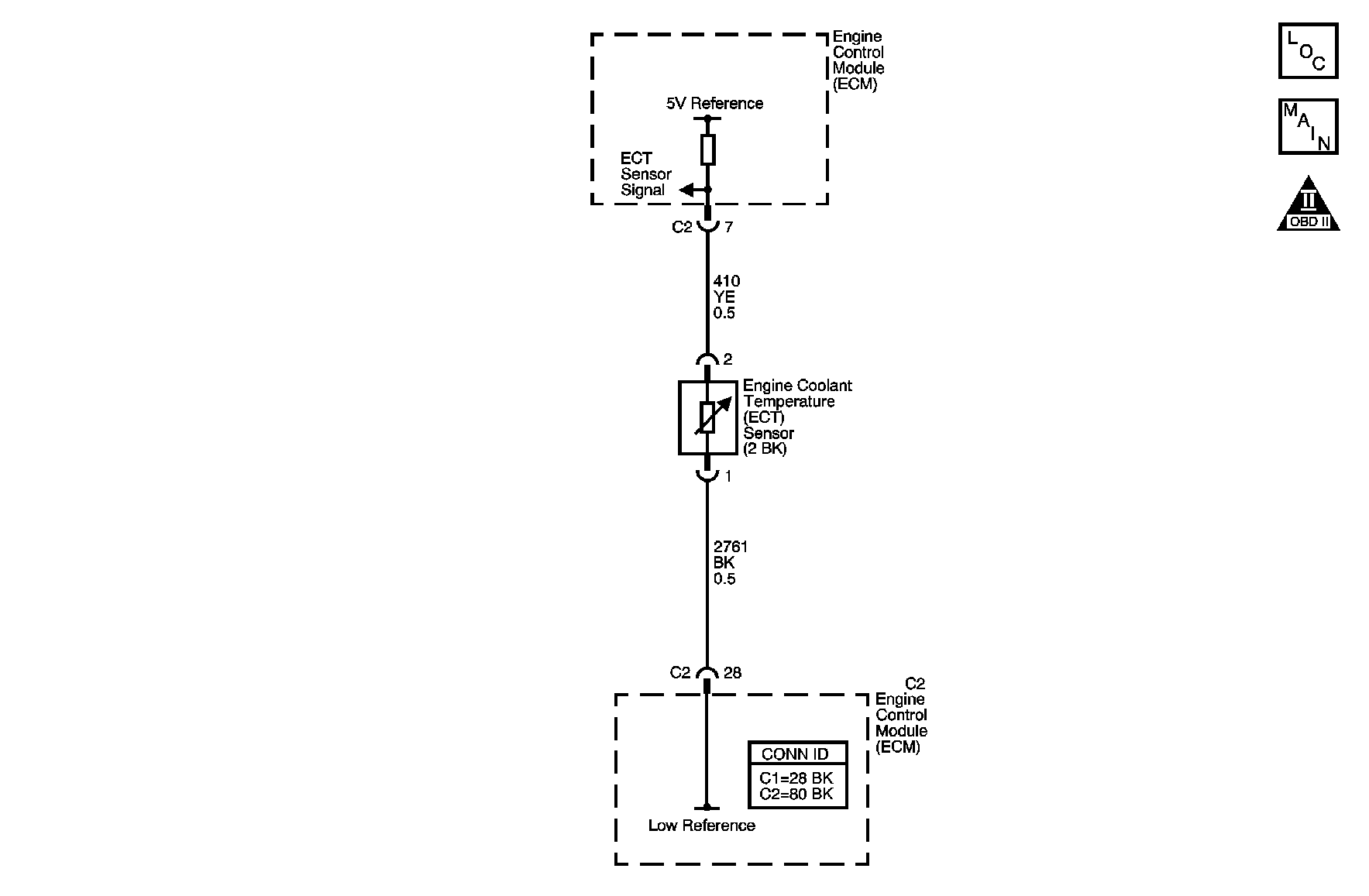
Circuit Description
The engine coolant temperature (ECT) sensor monitors the temperature of the coolant. This input is used by the engine control module (ECM) for engine control and as an enabling criteria for some diagnostics. The air flow coming into the engine is accumulated and used to determine if the vehicle has been driven within the conditions that would allow the engine coolant to heat up normally to the Closed Loop temperature. If the coolant temperature does not increase normally or does not reach Closed Loop temperature, the diagnostics that use ECT as enabling criteria may not run when expected.
This DTC will only run once per ignition cycle within the enabling conditions.
If the ECM detects that the calibrated amount of air flow and engine run time has been met and the engine coolant temperature has not risen to the required minimum temperature, DTC P0125 sets.
Conditions for Running the DTC
| • | DTCs P0106, P0107, P0108, P0112, P0113, P0116, P0117, P0118, P0128, P0500, P0601, P0602, P0606, P0641 are not set. |
| • | The engine has run more than 30 seconds and less than 1,800 seconds. |
| • | The start-up intake air temperature (IAT) is more than -7°C (19°F). |
| • | The start-up ECT is less than -1°C (30°F). |
| • | The vehicle has traveled more than 2 km (1.2 miles). |
| • | The calculated airflow is more than 12 g/s. |
Conditions for Setting the DTC
| • | The calibrated amount of engine run time has been met. |
| • | The calibrated amount of engine air flow has been met. |
| • | The engine coolant temperature for Closed Loop of 0°C (32°F) has not been met. |
Action Taken When the DTC Sets
| • | The control module illuminates the malfunction indicator lamp (MIL) on the second consecutive ignition cycle that the diagnostic runs and fails. |
| • | The control module records the operating conditions at the time the diagnostic fails. The first time the diagnostic fails, the control module stores this information in the Failure Records. If the diagnostic reports a failure on the second consecutive ignition cycle, the control module records the operating conditions at the time of the failure. The control module writes the operating conditions to the Freeze Frame and updates the Failure Records. |
Conditions for Clearing the MIL/DTC
| • | The control module turns OFF the malfunction indicator lamp (MIL) after 3 consecutive ignition cycles that the diagnostic runs and does not fail. |
| • | A current DTC, Last Test Failed, clears when the diagnostic runs and passes. |
| • | A history DTC clears after 40 consecutive warm-up cycles, if no failures are reported by this or any other emission related diagnostic. |
| • | Clear the MIL and the DTC with a scan tool. |
Diagnostic Aids
DTC P0125 is designed to detect a skewed ECT sensor or a faulty thermostat.
Test Description
The numbers below refer to the step numbers on the diagnostic table.
-
This step tests for excessive resistance in the ECT circuit.
-
This step tests for a skewed sensor through the range of temperatures affecting this DTC.
Step | Action | Values | Yes | No |
|---|---|---|---|---|
Schematic Reference: Engine Controls Schematics Connector End View Reference: Engine Controls Connector End Views or Engine Control Module Connector End Views | ||||
1 | Did you perform the Diagnostic System Check-Engine Controls? | -- | Go to Step 2 | |
2 | Is the cooling system coolant low? | -- | Go to Loss of Coolant in Engine Cooling | Go to Step 3 |
Is the ECT sensor parameter more than the specified value? | 149°C (300°F) | Go to Step 7 | Go to Step 4 | |
4 |
Is the ECT sensor parameter more than the specified value? | 149°C (300°F) | Go to Step 5 | Go to Step 6 |
5 | Test the ECT sensor low reference circuit for a high resistance or for an open. Refer to Circuit Testing and Wiring Repairs in Wiring Systems. Did you find and correct the condition? | -- | Go to Step 10 | Go to Diagnostic Aids |
6 | Test the ECT sensor signal circuit for a high resistance or for an open. Refer to Circuit Testing and Wiring Repairs in Wiring Systems. Did you find and correct the condition? | -- | Go to Step 10 | Go to Diagnostic Aids |
Does the resistance and temperature closely match the Temperature vs Resistance table? | 10-90°C (50-194°F) | Go to Step 8 | Go to Step 9 | |
8 | Install the ECT sensor. Refer to Engine Coolant Temperature Sensor Replacement . Is the action complete? | -- | Go to Thermostat Diagnosis in Engine Cooling | -- |
9 | Replace the ECT sensor. Refer to Engine Coolant Temperature Sensor Replacement . Did you complete the replacement? | -- | Go to Step 10 | -- |
10 |
Did the DTC fail this ignition? | -- | Go to Step 2 | Go to Step 11 |
11 | Observe the Capture Info with a scan tool. Are there any DTCs that have not been diagnosed? | -- | System OK | |
